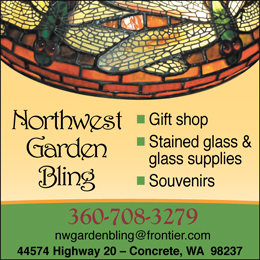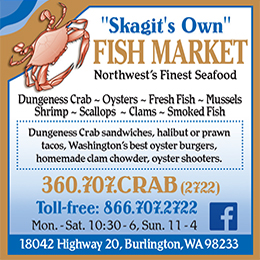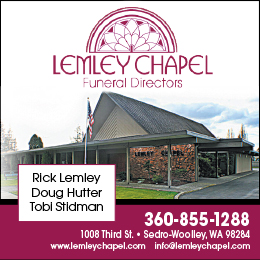Good with wood
Seventh-generation carver tells stories with a sharp edge.
(posted 1.11.10)
Rick Williams sits on his deck in late December, a piece of old-growth yellow cedar between his wrists and a pocket-knife cradled in his hands. He’s working on something that transcends mere art: He’s writing a story with a knife, one that will be retold for generations.
On the deck and its railing sit samples of the totem poles he carves, some only inches long, one almost five feet and as thick as his neck. They surround him like children, like ancestors. A cold sun is out, but Williams’ fingers move steadily, surely, slicing and gouging the wood.
Williams is a Nitinaht Indian (“Ditidaht” in his native language), a seventh-generation carver who takes his time with each totem pole he carves, working only with an average-sized pocketknife, using techniques and carving styles passed down to him from his father and grandfather—and many fathers before them.
His carvings are for sale, but you won’t find them online or in galleries. You can’t call him to order one; he has no phone. Potential buyers must travel—and travel they do—to his home at 45479 Main Street in Concrete to view his work.
Williams, 54, lives here with his Swiss wife, Dunja, and three sons: Thunderheart, 16; Eagleson, 15; and Hawkman, 14. His sons are learning how to carve in the Williams style, too.
Looks like home
The Nitinaht nation is located on a reservation at the southern tip of Vancouver Island. Williams and his family left the reservation and came to Concrete about 11 years ago, settling here because the area looks similar to the reservation and Dunja’s native Switzerland.
“Relatives kid me about the lot I chose here on Main Street, between Sam’s Alley and Nellie Lane,” Williams laughs. “They say I couldn’t stand to be too far from family.” His grandparents were named Sam and Nellie.
The journey
All artists have a story of their journey; Williams is no exception. His began at age 5 when he attended a carvers’ gathering at Thunderbird Park in Victoria, B.C., in December 1960.
“I sat with the finest carvers in those days. Mango Martin, Henry Hunn, Baptist Paul . . . Baptist Paul handed me a pocketknife and I’ve been carving ever since,” he says in a calm, quiet voice.
Williams’ pieces tell stories, but not the kind of stories you might expect. They have no beginning, middle, and end. They have no plot. Rather, they are rife with symbolism, referencing people, events, life choices, and wise counsel. And you read each totem’s story from the bottom up.
“Every totem tells two stories at the same time, so there are different ways to read it,” says Williams. “You can look at it to see achievements or actions in someone’s life. You can also look at it to see what the animal spirits would like to share with you.”
Good wood
Durable, old-growth yellow cedar is Williams’ wood of choice, with old-growth red cedar coming in second. People bring him most of the wood he uses, and he sets to work with his pocket-knife. At the street’s edge in front of his house, there’s an aging power pole that’s showing signs of rot at ground level. It will need to be replaced, probably within a few years.
“That’s yellow cedar,” Williams says of the massive pole. “I’d like to see that thing lying in my front yard.”
Worth waiting for
This isn’t assembly-line art. Williams uses no power tools; he once spent an entire year working on an 8-ft. piece.
But that’s precisely what makes him sought-after. He does little marketing, if any, but customers still manage to find him. He’s sold totems to tourists visiting from Taiwan and Switzerland, and put his work on gift shop shelves in Seattle and elsewhere, but he prefers direct, private sales. That’s why you’ll see him sitting in front of his house during townwide events, his totems on display, hoping to draw people in for a conversation first, and a potential sale second. He likes to meet his customers in person, shake their hands, encourage them to slow down, “keep an open mind, hold [a piece] and close your eyes and listen, and you’ll find the carving that fits you.”
Customers sometimes miss the depth beneath the beauty of Williams’ carvings. “I put my heart and soul into everything I carve,” he says.
That passion, combined with the train-ing he received from his grandfather, Sam, and his father, Ray, is what makes his work unique in the purest sense.
Because of that mentorship, Williams’ works bear great resemblance to those carved by his fathers. An eye here, a tooth there—if you know what you’re looking for, you can spot the similarities.
“I sold one of Rick’s totems to a man who had bought one that Rick’s father had done,” says Dunja. “They were almost identical in style.”
It’s that kind of connection to family history that imbues all of Williams’ pieces. And it’s that connection that Williams refuses to break.
“I want to keep it alive—that ability to tell a story with a pocketknife” he says. “That’s why I’m teaching my sons to carry on this tradition,” he says.
Williams hesitates in mid-cut, then speaks even more softly than before. “As long as I’m above ground, I’ll carve. Someone has to tell these stories.”
—J.K.M.






